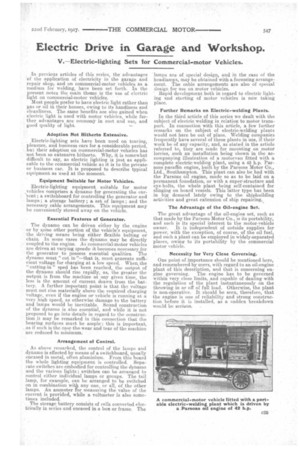Electric Drive in Garage and Workshop.
Page 5

If you've noticed an error in this article please click here to report it so we can fix it.
V.—Electric-lighting Sets for Commercial-motor Vehicles.
In previous articles of this series, the advantages of the application of electricity in the garage and repair shop,, and on commercial-motor vehicles as a Medium for welding, have been set forth. In the present notes the 'main theme is the use of electric light on commerciaI-motor vehicles. "
Most people prefer to have electric light rather than gas or oil in their houses, owing to its handiness and cleanliness. The same benefits are also gained when electric light is used with motor vehicles, while further advantages are economy in cost and use, and good quality of light.
Adoption Not Hitherto Extensive.
. Electric-lighting sets have been used on touring, pleasure, and business cars for a considerable period, but their adoption on commercial-motor vehicles has not been so extensive hitherto. Why, it is somewhat difficult to say, as electric lighting is just as applicable to the commercial vehicle as it is to the private or business car. It is proposed to describe typical • equipment as used at the moment.
Equipment Suitable for Motor Vehicles.
Electric-lighting equipment suitable for motor vehicles comprises a. dynamo for generating the cur‘.ent ; a switchboard for controlling the generator and lamps ; a storage battery ; a set of lamps ; and the necessary cable arrangements. This equipment may be conveniently stowed away on the vehicle.
Essential Features of Generator.
The dynamo can be driven either by the engine or by some other portion of the vehicle's equipment, the driving means being either flexible belting or chain. In some eases the dynamo may be directly 'coupled to the engine. As -commercial-motor vehicles are driven at varying speeds, it becomes necessary for the generator to possess essential qualities. The dynamo must "cut in "—that is. must generate suffi-• ment voltage for charging at a low speed. 'When, the " cutting-in " sped has been reached, the output of the dynamo should rise rapidly, as, the greater the output is from the .machine at any given time, the less is the amount of current drawn from the bat(cry. A further important point is that the voltage must not rise materially above the required charging voltage, even if the engine or vehicle is running at a very high speed, as otherwise damage to the battery and lamps would be inevitable. Sound construction of the dynamo is also essential, and while it is not proposed to go into details in regard to the .construction it may be remarked in this connection that the bearing surfaces must be ample; this is important, as if such is the ease the wear and tear of the machine are reduced to minimum.
Arrangement of Control.
As above remarked, the control of the lamps and dynamo is effected by means of a switchboard,. usually encased in metal, often aluminium. From this board the whole lighting equipment is controlled. Separate switches are embodied for controlling the dynamo and the various lights ; switches can be arranged to control either individual lamps or groups. The tail lamp, for example, can be arranged to be switched on in combination with any one, or all, of the other lamps. An ammeter for measuring the value of the current is provided, while a voltmeter is also sometimes included.
. The storage battery consists of cells converted electrically in series and encased in a box or frame. The lamps are of special design, and in the case of the headlamps may be obtained with a focussing arrangement. The cable arrangements are also of special design for use on motor vehicles.
' _Rapid development both in regard to electric lighting and starting of motor vehicles is now taking,. place.
Further Remarks on Electric-welding Plants.
In the third article of this series we dealt with the subject of electric welding in relation to motor transport. In connection with this article, a few further remarks on the subject of electric-welding plants would not here be out of place. Welding companies frequently have several of these plants in use, if their work be of any capacity, and, as stated in the article referred to, they are made for mounting on motor lorries, such an installation being shown in the accompanying illustration of a motorvan fitted with a. complete electric-welding plant, using a 42 h.p. Parsons paraffin engine, built by the Parsons Motor Co., Ltd., Southampton. This plant can also be had with the Parsons oil engine, mine so as to be laid on a permanent foundation, or with a super-structure and eye-bolts, the whole plant being self-contained for slinging on board vessels. This latter type has been in big demand lately owing to the shipbuilding activities and great extension of ship repairing..
The Advantage of the Oil-engine Set.
The great advantage of the oil-engine set, such as that made by the Parsons Motor Co., is its portability, and such is its special interest to the motor-vehicle owner. It is independent of outside supplies for power, with the exception, of course, of the oil fuel, and such a plant can be employed in widely-separated places, owing to its portability by the commercial motor vehicle.
Necessity for Very Close Governing.
One point of importance should be mentioned here, and remembered by users, with regard to an oil-engine plant of this description, and that is concerning en
gine governing. The engine has to be governed within very close limits, and capable of dealing with the regulation of the plant instantaneously on the throwing in or off of full load. Otherwise, the plant is non-operative. It should be seen, therefore, that the engine is one of reliability and strong construction before it is installed, as a sudden breakdown
would be serious.
























